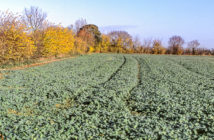Potato crops are under increasing blight pressure, with repeated hits of Hutton Criteria that indicate infection risks.
The Hutton Criteria has now largely replaced conventional Smith periods, since blight outbreaks were still occurring even when a Smith Period had not been triggered, reports Syngenta eastern counties potato specialist, David Wilson.
“This season BlightCast disease risk forecasting has already repeatedly triggered Hutton Criteria warnings, particularly in hot, humid thundery weather with localised downpours,” he warned. “Many crops are emerging and going through rapid canopy growth, with new leaves which are especially vulnerable to infection, just as the risk is building.
“During this time it is essential to maintain the most effective foliar protection available, with leading EuroBlight foliar fungicides such as Revus for combined leaf blight, new growth and protectant properties.”
Hutton Criteria is believed to better reflect conditions where new strains of blight can actively develop, by reducing the period of relative humidity at 90 per cent or above down to six hours, from an eleven hour period used to trigger a Smith Period,
Mr Wilson pointed out experience at the Eurofins trials site in Derbyshire last year demonstrated the effectiveness of new Hutton Criteria in forewarning blight outbreaks.
“BlightCast showed the first Hutton Criteria hits for the site were on the 18thAugust, but no Smith Periods triggered until 22ndAugust; in that time the visual assessment of blight inoculated trials went from virtually nothing detectable to widespread infection.”
“Furthermore, Syngenta remote sensing of the trials site by aerial crop health imagery clearly indicated when and where infection was running through untreated plots.”
“Where growers and agronomists can use this information for better timing of Revus applications, it could help protect from foliar blight more effectively,” he advocated.
“Alongside the use of products with tuber blight activity, part of the clear AHDB advice this season is to prevent foliar blight infection to minimise the risk of tuber blight, using the best EuroBlight foliar fungicides available, and avoiding stretching application intervals beyond the weakest link in any mix application.”
He also cited the importance of Revus’ rainfast properties, which is recognised as being a significant advantage in catchy wet conditions – which are the most challenging for application during high blight risk periods.
“With a new blight option this season, there is the real chance to beef up protection when it’s used in a programme with Revus and other effective blight products.
“The challenges posed by dark green 37_A2 and reduced sensitivity to fluazinam are well documented. Robust programmes, as part of an integrated approach to blight management, that follow AHDB and FRAG-UK advice will offer the best way to counter this challenge and protect crops that have emerged into high blight risk conditions he added.
Growers and agronomists can register for localised BlightCast warnings for their crops at www.syngenta.co.uk/blightcast




